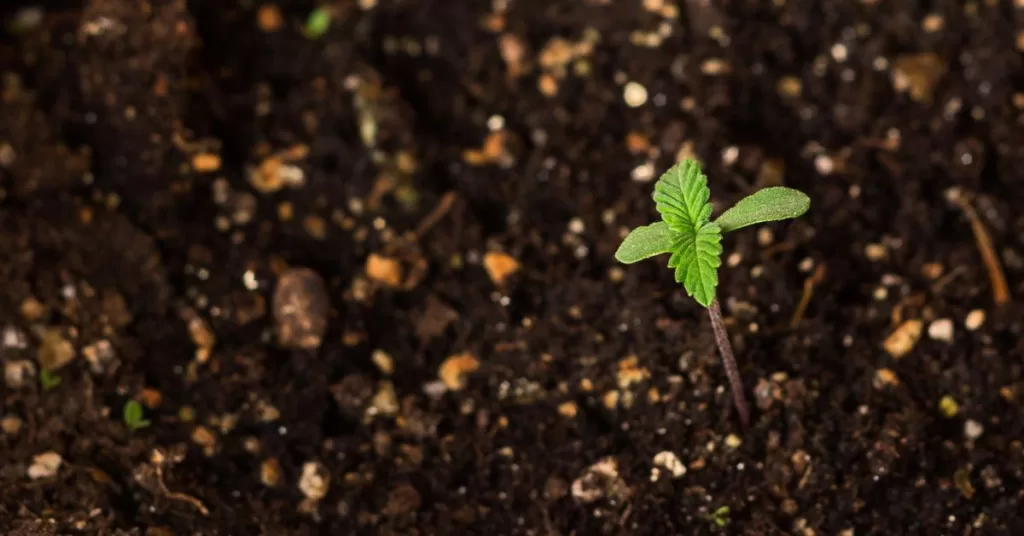Cannabis cultivation is a rewarding enterprise, but it requires careful management of various factors, including light, temperature, water, and nutrients.
The right cannabis fertilizers can dramatically enhance your cannabis yield and quality, but choosing the best one can be daunting, given the many available options.
This guide aims to simplify this process by providing a comprehensive review of the best cannabis fertilizers.
Table of Contents
Understanding Plant Nutrients and Cannabis Fertilizers
Before delving into the best cannabis fertilizers, it is crucial to understand what nutrients your cannabis plants need and how fertilizers contribute to their growth and health.
Essential Nutrients for Cannabis
Cannabis plants require a combination of primary nutrients — Nitrogen (N), Phosphorus (P), and Potassium (K) — also known as macronutrients, secondary nutrients including sulfur (S), magnesium (Mg), and calcium (Ca), and trace or micronutrients such as iron (Fe), manganese (Mn), zinc (Zn), copper (Cu), boron (B), molybdenum (Mo), chlorine (Cl), and nickel (Ni).
The macronutrients are essential for essential plant functions like photosynthesis and cell division, while the secondary and micronutrients aid in enhancing yields and crop quality.
What are cannabis fertilizers?
Fertilizers, often referred to as “plant food,” are materials applied to soil or plant tissue to supply the plant with the much-needed nutrients and improve its health and yield.
They are either synthetic or organic and provide the three main compounds found in any fertilizer: Nitrogen (N), Phosphorus (P), and Potassium (K).
Macronutrient fertilizers primarily contain NPK, whereas micronutrient fertilizers tend to have nutrients like boron, copper, iron, and more.
In addition, certain products like mycorrhizal fungi can be added to soil, coco coir, Rockwool, and other inert growth media to enhance nutrient absorption.
NPK Requirements in Cannabis Fertilizers
The nutrient needs of cannabis plants vary depending on the stage of growth, specifically when it comes to the primary nutrients: Nitrogen (N), Phosphorus (P), and Potassium (K).
Understanding the N-P-K requirements at different growth stages can help you optimize your cannabis cultivation, whether for personal or commercial use.
Vegetative Stage:
N-P-K Ratio: High Nitrogen, Medium Phosphorus, High Potassium
Example Ratio: 3-1-2 or 4-2-3
During the vegetative stage, cannabis plants are focused on growing leaves and stems, processes that require a lot of nitrogen. A balanced amount of potassium is also necessary for overall cellular functions and vigor. Phosphorus needs are comparatively lower at this stage but still essential.
Transition to Flowering:
N-P-K Ratio: Balanced
Example Ratio: 2-2-2 or 1-1-1
As the plant transitions to the flowering stage, the nutrient requirements start to shift. A balanced N-P-K ratio during the first couple of weeks of flowering can provide the necessary nutrients for this phase.
Flowering Stage:
N-P-K Ratio: Low Nitrogen, High Phosphorus, High Potassium
Example Ratio: 1-3-2 or 0-3-3
Phosphorus and potassium are crucial during the flowering stage for bud development. Phosphorus helps with flower and root formation, while potassium aids in the maturation of the flowers and improves disease resistance. Nitrogen is still needed but in lower amounts compared to the vegetative stage.
Late Flowering Stage:
N-P-K Ratio: Very Low Nitrogen, Medium to High Phosphorus, High Potassium
Example Ratio: 0-2-3 or 0-3-4
In the last weeks leading to harvest, the plant needs very little nitrogen. A higher concentration of potassium helps with bud density and overall ripening, while a moderate amount of phosphorus continues to support flowering.
Choosing Between Organic and Synthetic Fertilizers
When it comes to choosing between organic and synthetic cannabis fertilizers, it largely depends on your preference and cultivation practices.
Organic fertilizers, made from natural materials like worm castings, bat guano, and fish meal, are environmentally friendly and slowly release nutrients into the soil, making them less likely to cause nutrient burn and you harvest organic cannabis.
On the other hand, synthetic fertilizers, often made from industrially produced substances, provide plants with immediate nourishment.
These fertilizers work faster and may be less time-consuming, making them a good choice for growers who prefer a more straightforward approach.
What are the Best Cannabis Fertilizers on the Market?
With a basic understanding of plant nutrients and fertilizers, let’s move on to a detailed review of the best cannabis fertilizers, categorized based on their performance, ease of use, and effectiveness.
Big Boom PK 52-34 by Boom Nutrients
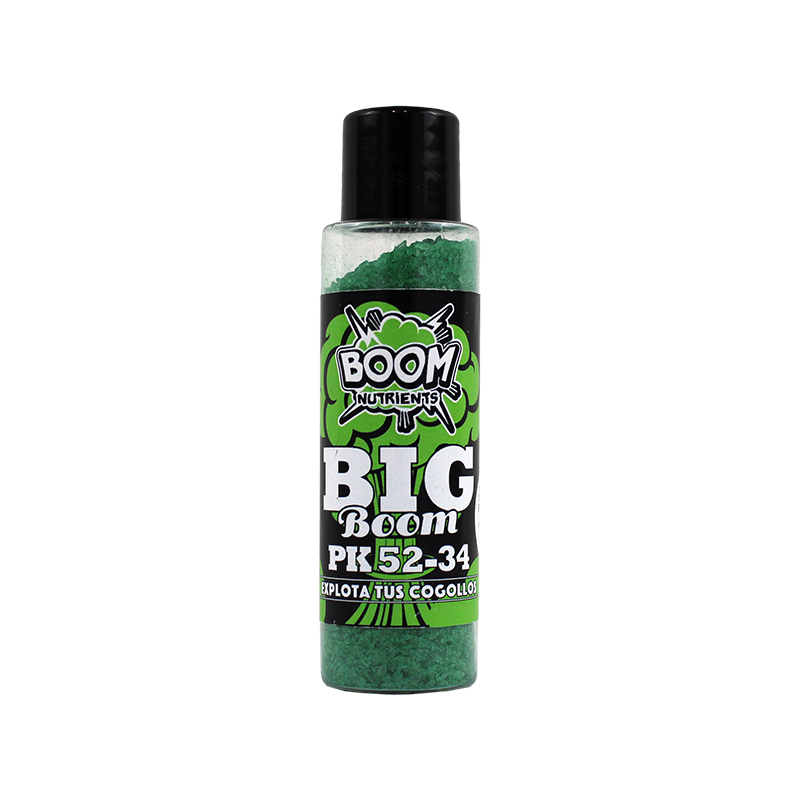
Big Boom PK 52-34 is a fertilizer primarily designed to enhance your cannabis flowers. It boasts a high concentration of phosphorus and potassium, making it ideal for the flowering phase of your cannabis plants.
This fertilizer is particularly popular among both amateur and professional growers due to its remarkable results.
Bloombastic by Atami
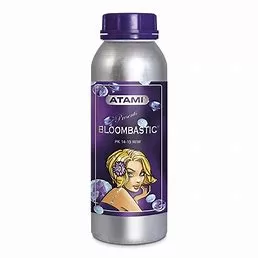
Bloombastic is an all-rounder fertilizer that provides extra phosphorus and potassium, along with sugars and hydrates, to promote abundant flowering and large resin-covered flowers. This product has gained a solid reputation worldwide, thanks to its incredible results.
Canna Fertilizer Kit
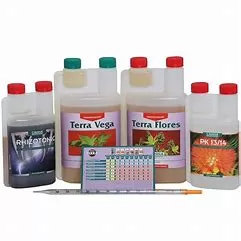
The Canna Fertilizer Kit is a complete nutrient solution for your cannabis plants.
The kit includes six fertilizers responsible for developing a robust and healthy plant structure that will eventually offer dense and considerably resinous flowers.
It includes nutrients for both the growth and flowering stages, providing a comprehensive nutritional solution for your cannabis plants.
CalMag by Elite 91
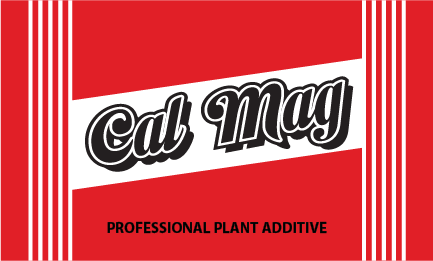
CalMag by Elite 91 provides essential nutrients like nitrogen, calcium, magnesium, and iron.
It is particularly useful in correcting the deficiencies of cannabis plants regarding these elements, thereby increasing production and achieving bigger growth.
Delta 9 by Cannabiogen
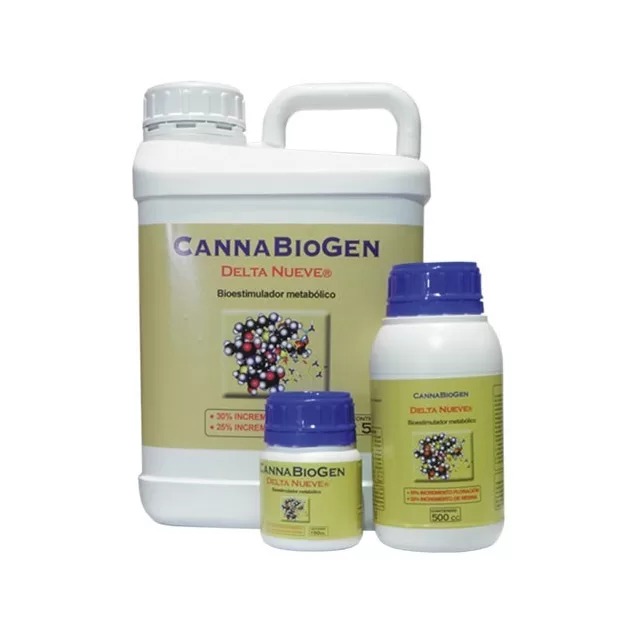
Delta 9 is a renowned flower stimulator. It provides a large number of nutrients and other elements to achieve heavy buds and intense aromas. This product is known to help the plant’s photosynthetic apparatus and activate its metabolism.
The Importance of Fertilizer Timing
The timing of fertilizer application is crucial for the health and productivity of your cannabis plants. Generally, cannabis plants require different nutrient profiles during the vegetative and flowering stages.
During the vegetative phase, plants need higher amounts of Nitrogen to support foliage growth, whereas, in the flowering stage, cannabis requires more Phosphorus and Potassium to develop buds, while the Nitrogen requirement decreases.
Tailoring Cannabis Fertilizers to Your Growing Medium
The type of growing medium you use for your cannabis plants can also influence your choice of fertilizers. For instance, if you’re using soil, opt for nutrient solutions specifically designed for soil-based growing.
For soilless mediums like coco coir or hydroponic systems, choose nutrient solutions designed for use in these mediums. These nutrients will contain no organic matter as they are provided through minerals and should contain optimum NPK ratios.
What are the guidelines for mixing cannabis fertilizers?
Soil Testing: Before adding any fertilizers, it’s best to test the soil to understand which nutrients are lacking.
Follow Instructions: Always read and follow the instructions that come with commercial fertilizers.
Application Frequency: Organic fertilizers generally break down more slowly and release nutrients over a longer period, while synthetic fertilizers often require more frequent applications.
pH Level: Ensure that the pH level of the soil is appropriate for cannabis growth (usually around 6-7 for soil).
Nutrient Ratio: During the vegetative stage, use a fertilizer high in nitrogen. During the flowering stage, switch to a fertilizer high in phosphorus and potassium.
Calcium and Magnesium: Sometimes additional Cal-Mag supplements are required, especially if you notice deficiencies in the plants.
FAQs
What are the Best fertilizers to mix with soil for outdoor cannabis grow?
The “best” fertilizers for outdoor cannabis cultivation depend on several factors, including: Soil quality, local climate, strain of cannabis, budget and availability of products.
They are also plant fertilizers are acceptable to use with cannabis
Here are some general guidelines:
Organic Options:
Compost: Rich in nutrients and serves as a great soil conditioner.
Bat Guano: High in nitrogen and phosphorus, it promotes robust vegetative growth and flowering.
Bone Meal: Provides phosphorus, which is essential for root and flower development.
Blood Meal: High in nitrogen, stimulates vegetative growth.
Fish Emulsion: Rich in nitrogen and other trace minerals but has a strong smell.
Alfalfa Meal: Provides balanced N-P-K (Nitrogen-Phosphorous-Potassium) and acts as a soil conditioner.
Synthetic/Chemical Options:
Water-Soluble N-P-K fertilizers: These are easy to use but need to be applied more frequently.
Controlled-Release fertilizers: These release nutrients over time, reducing the frequency of application.
Liquid Fertilizers: Quick and easy to apply but typically require regular applications.
Specific Nutrients:
Nitrogen (N): Important for vegetative growth.
Phosphorus (P): Important for root and flower development.
Potassium (K): Important for the overall vigor and resistance to diseases.
What are the best fertilizers for indoor cannabis?
For indoor cannabis cultivation, fertilizer choice is key to maximizing yield and plant health.
Choose fertilizers based on your plant’s growth stage: high in nitrogen for vegetative growth and high in phosphorus and potassium for flowering. Always start with lower doses to avoid nutrient lockout.
Organic Options: Compost, Bat Guano, and Bone Meal are good for overall nutrient balance.
Synthetic/Chemical Options: Water-Soluble N-P-K fertilizers and Liquid Fertilizers are easy to apply and control.
How to cleanse cannabis plant of fertilizers
Flushing cannabis plants is a crucial step to remove excess nutrients and fertilizers before harvest, thereby improving the quality of the final product.
In soil-based grows, the process generally starts two weeks before the expected harvest date. For hydroponic systems, flushing begins about one week prior to harvest.
For soil grows, simply water the plants with plain, pH-balanced water, aiming for a pH range of 6-7. Use enough water to create runoff from the bottom of the pot, effectively leaching out excess nutrients. Continue this practice until harvest.
In hydroponic systems, remove the existing nutrient solution and replace it with clean, pH-balanced water.
Run the system as usual but without adding any nutrients. Keep an eye on the plant’s condition during this period; yellowing leaves are typically a sign that the plant is using up its stored nutrients, indicating a successful flush.
Parting Remarks on the Best Cannabis Fertilizers
Choosing the best fertilizer for your cannabis plants involves understanding your plants’ nutritional needs, your growing medium, and the various fertilizer options available.
The best fertilizer for your cannabis plants is the one that fits your cultivation practices and helps your plants thrive, producing bountiful, high-quality cannabis buds.
Remember that over-fertilization can lead to nutrient lockout or even kill the plants. Always start with smaller doses and work your way up as needed.
